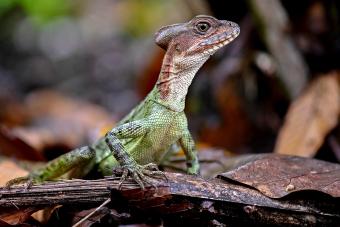
Tree frogs have unique care requirements, and their habitat requirements differ from that of other frogs, such as the bullfrog. Arboreal frogs prefer to spend their time in trees rather than on land. When keeping one as a pet, it's critical to replicate its natural environment as closely as possible. Learning how to create an appropriate habitat will help ensure your new pet's health and happiness.
Habitat Requirements
To maintain your green tree frog in an environment with suitable conditions, you'll need to educate yourself on their required humidity levels, habitat size, temperature, and lighting requirements. Grasping how to effectively replicate their natural surroundings while combining all of these aspects is also a necessary part of the process.
Terrarium
The first step involves choosing the proper terrarium. The terrarium should be taller than it is wide to allow them to room climb and explore. The actual size of the terrarium is dependent upon whether you have one or multiple tree frogs. If you have one or two Green Tree Frogs, a 12- by 12- by 18-inches is sufficient (though larger enclosures are always better). If you have more than two tree frogs, you will need to increase their space accordingly. If you are inexperienced with tree frog habitat development, some pet stores do offer starter kits.
Once you have chosen a terrarium, you can begin setting it up. Rinse out the aquarium once you get it home to ensure it's clean and ready to go. It's also much easier to determine where to place the terrarium prior to adding all the materials. Once the materials are added, not only will the terrarium be heavy, but the materials inside are likely to move around and not be placed where they should be.
Substrate
Although Green Tree Frogs won't be in contact with the substrate often, it's still important to choose one that's frog-safe. Eco Earth is a frequently recommended substrate, but you do have other options. Other types of tank substrate include coconut fiber, astroturf, bark, dampened sphagnum moss, reptile carpet, or a mixture of these. You should avoid using any type of bite-size pebbles, as they can cause an obstruction if your pet tree frog consumes them.
Adding the Natural Element
Green tree frogs require elements in their tank that replicate their natural habitat. Driftwood, cork bark, and branches are all common objects found in terrariums. Acquire these from a pet store, as collecting wood from the outdoors can introduce parasites or toxins into your frog's habitat.
If you prefer to utilize natural wood from the outdoors, you can cleanse it with a mix of water and bleach to rid it of parasites and hazardous bacteria. You should soak for at least 24 hours, preferably longer, and then rinse thoroughly and allow it to dry for several days prior to placing it in the terrarium.
Because green tree frogs prefer dense vegetation, their tank should contain numerous dark leafy regions for them to hide under and climb through. You can utilize terrarium-specific fake plants. If you prefer to use live plants, you may do so as long as they are not harmful to your frog. Ferns, orchids, philodendrons, pilea, and bromeliads are safe choices for your new pet.
Choosing a Water Dish
Although green tree frog are amphibians, they don't swim well and should have a shallow water dish to prevent drowning. If you are using water from your tap, purchase an amphibian-safe water treatment like ReptiSafe Water Conditioner to supply fresh drinking water.
Humidity, Temperature, and Lighting
Your Green Tree Frog's terrarium should have an ambient temperature between 70 and 82 degrees Fahrenheit, and at least 50 percent humidity. Additionally, they will require a basking area, which can be provided by a heat lamp or an under-the-tank heater. The heater should be placed near one of the tank's ends, not in the center, to allow them to escape the heat when necessary.
Along with a bowl of water to maintain humidity in the tank, you should mist the tank daily using a spray bottle or an attached mister. Because it is critical to monitor the correct temperature and humidity levels, purchase a dual thermometer and humidity gauge for your tank from your local pet store and check it daily.
They do not require ultraviolet lighting, unlike other reptiles and amphibians, though you may want one if you have natural plants. Due to the nocturnal nature of the frogs, the lamp should be switched off to provide them with at least 12 hours of darkness per day, although they can enjoy up to 14 hours of light during the summer. Additionally, you can utilize a night-specific bulb in the evening and a fluorescent bulb during the day.
Is a Green Tree Frog Right for You?
While green tree frogs do not require constant attention, their vibrant colors and attractive planted tanks make them an eye-catching addition to any home. Due to the fact that they produce little waste and eat just a few days per week, they do not require frequent tank cleaning. They make wonderful first-time reptile hobbyists' pets.







